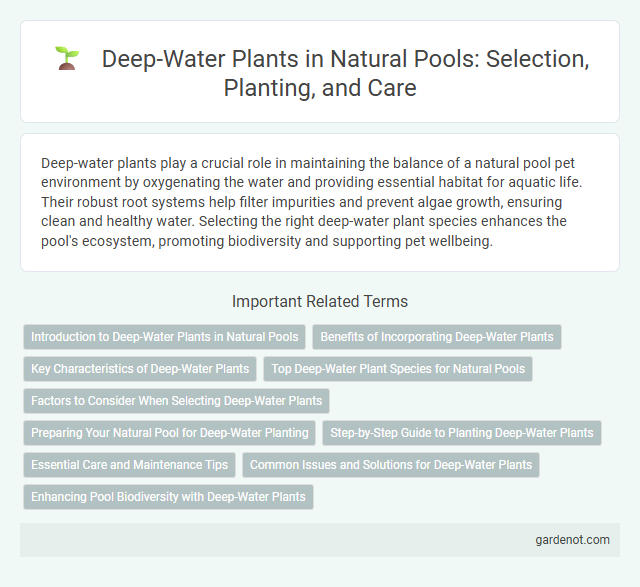Deep-water plants play a crucial role in maintaining the balance of a natural pool pet environment by oxygenating the water and providing essential habitat for aquatic life. Their robust root systems help filter impurities and prevent algae growth, ensuring clean and healthy water. Selecting the right deep-water plant species enhances the pool's ecosystem, promoting biodiversity and supporting pet wellbeing.
Introduction to Deep-Water Plants in Natural Pools
Deep-water plants in natural pools serve a crucial role in maintaining water clarity and ecological balance by absorbing excess nutrients and providing habitat for aquatic life. Species such as water lilies, hornwort, and pondweed thrive in submerged conditions, contributing to oxygenation and stabilizing sediment. Their presence enhances the natural filtration system, reducing algae growth and supporting a healthier aquatic environment.
Benefits of Incorporating Deep-Water Plants
Deep-water plants enhance natural pools by improving water clarity through nutrient absorption, which reduces algae growth and maintains ecological balance. Their extensive root systems stabilize sediment, preventing erosion and promoting a healthy aquatic environment. These plants also provide habitat for beneficial microorganisms and aquatic life, fostering biodiversity within the pool ecosystem.
Key Characteristics of Deep-Water Plants
Deep-water plants thrive in depths ranging from 1 to 6 meters, featuring elongated, flexible stems that allow them to withstand water currents and reach sunlight efficiently. Their leaves are often thin and dissected, maximizing surface area for photosynthesis while reducing resistance to water flow. These plants play a crucial role in oxygenating the water and providing habitat for aquatic life within natural pools.
Top Deep-Water Plant Species for Natural Pools
Top deep-water plant species for natural pools include Hornwort (Ceratophyllum demersum), known for oxygenating water and preventing algae growth, and Water Lilies (Nymphaea spp.) which provide shade and improve pool aesthetics. Submerged plants like Vallisneria and Elodea enhance water clarity by absorbing nutrients, reducing the risk of eutrophication. Choosing a diverse mix of these deep-water plants ensures balanced ecosystem health and natural filtration in your pool.
Factors to Consider When Selecting Deep-Water Plants
Selecting deep-water plants for a natural pool requires careful consideration of water depth, as these plants thrive in depths ranging from 12 to 24 inches. Light availability is crucial since deep-water plants need adequate sunlight for photosynthesis, influencing pool design and plant placement. Water quality parameters such as nutrient levels and pH also impact plant health and growth, necessitating regular monitoring to maintain an optimal environment.
Preparing Your Natural Pool for Deep-Water Planting
Preparing your natural pool for deep-water planting involves selecting aquatic plants suited for submersion at depths of 12-24 inches to promote a balanced ecosystem. Ensure the pool's deep zones have stable water temperatures and adequate sunlight exposure, as these conditions support healthy root development and photosynthesis. Incorporate nutrient-rich substrate or planting baskets to anchor deep-water plants such as hornwort, anacharis, or cabomba, enhancing water clarity and oxygen levels naturally.
Step-by-Step Guide to Planting Deep-Water Plants
Planting deep-water plants in a natural pool begins with selecting species like hornwort, anacharis, or pondweed that thrive fully submerged. Ensure water depth ranges from 24 to 48 inches to accommodate root anchoring and optimal sunlight exposure. Use weighted baskets filled with aquatic soil to secure plants underwater, gradually lowering them to prevent disturbance and promote healthy growth.
Essential Care and Maintenance Tips
Deep-water plants in natural pools require consistent monitoring to maintain water quality and promote healthy growth. Regularly remove dead or decaying leaves to prevent nutrient buildup that can lead to algae growth, ensuring the plants receive adequate sunlight and oxygenation. Supplemental feeding every 6-8 weeks with aquatic plant fertilizer supports vigorous development and resilience against pests.
Common Issues and Solutions for Deep-Water Plants
Deep-water plants in natural pools often face issues such as nutrient deficiencies, algae overgrowth, and poor oxygenation. Addressing these problems involves balancing nutrient levels through controlled fertilization, implementing regular water circulation to improve oxygen distribution, and managing shading to reduce excessive algae growth. Regular monitoring and selective pruning also help maintain healthy plant growth and ecosystem stability.
Enhancing Pool Biodiversity with Deep-Water Plants
Deep-water plants, such as hornwort and elodea, play a crucial role in enhancing pool biodiversity by providing habitat and oxygenation in natural pools. Their submerged leaves offer shelter for aquatic insects and fish, promoting a balanced ecosystem and improved water quality. Incorporating a variety of deep-water plants increases nutrient uptake, reducing algae growth and maintaining ecological stability.
Deep-water plant Infographic

 gardenot.com
gardenot.com